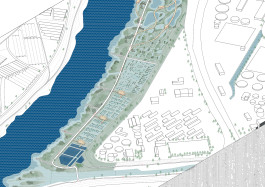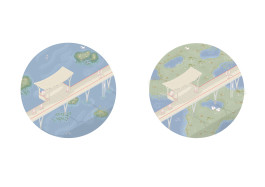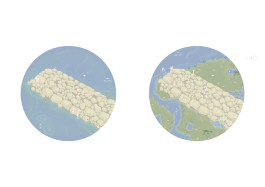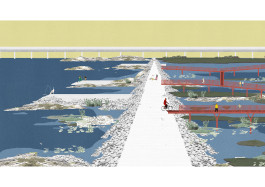New Waters for Geumho River
Mai-Vy Lejeune, Lazuli Vingtain
Urban Nature
Our project is based in the western outskirts of Daegu, along the Geumho river and its alluvial plain. We wanted to tackle the question of water in the city. Our line of focus is therefore the interaction the cityscape entertains with this natural landscape that flows through it, which was progressively contained, domesticated through rapid industrialization. Our intervention is situated along the riverbanks that work as containment dikes along the river and serve as limits between the water and the land.
With this massive industrialization, what diversity has been lost by controlling the flow of rivers?
How can we make the city and river grow together?
The aim of the project is to integrate these residual spaces to the urban fabric, revalorize a fluvial valley condition that has been lost throughout this evolution and take part in the Industrial ecosystem of Daegu (water treatment plants, textile industries) by extending the water circuit into phyto epuration ponds, artificial wetlands, recreational areas, before being dispatched in the river.
The project aims to be a prototype, so it must be read as an experiment of what can be made somewhere else along the hose riverbanks. It works as a system that thrives on the dynamics of the river landscape and makes way for a new biological condition. A wetland that will work as a gradient, a buffer zone that blurs the boundary between the land and the river: using dikes as an aggregating sedimentation process to extend the riverbanks and, at the same time, allowing the water to enter in the land. New uses are introduced, allowing both pedagogical/research and recreational areas. The dikes work as the main axis along the edges, connecting these different uses in a long promenade where people can observe, stroll, fish, play, bike and contemplate a changing landscape.










New Waters for Geumho River
Mai-Vy Lejeune, Lazuli Vingtain
Urban Nature










Our project is based in the western outskirts of Daegu, along the Geumho river and its alluvial plain. We wanted to tackle the question of water in the city. Our line of focus is therefore the interaction the cityscape entertains with this natural landscape that flows through it, which was progressively contained, domesticated through rapid industrialization. Our intervention is situated along the riverbanks that work as containment dikes along the river and serve as limits between the water and the land.
With this massive industrialization, what diversity has been lost by controlling the flow of rivers?
How can we make the city and river grow together?
The aim of the project is to integrate these residual spaces to the urban fabric, revalorize a fluvial valley condition that has been lost throughout this evolution and take part in the Industrial ecosystem of Daegu (water treatment plants, textile industries) by extending the water circuit into phyto epuration ponds, artificial wetlands, recreational areas, before being dispatched in the river.
The project aims to be a prototype, so it must be read as an experiment of what can be made somewhere else along the hose riverbanks. It works as a system that thrives on the dynamics of the river landscape and makes way for a new biological condition. A wetland that will work as a gradient, a buffer zone that blurs the boundary between the land and the river: using dikes as an aggregating sedimentation process to extend the riverbanks and, at the same time, allowing the water to enter in the land. New uses are introduced, allowing both pedagogical/research and recreational areas. The dikes work as the main axis along the edges, connecting these different uses in a long promenade where people can observe, stroll, fish, play, bike and contemplate a changing landscape.